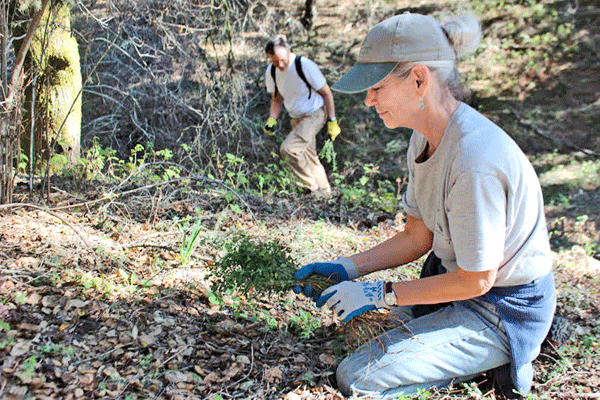Some 20 volunteers spent their Martin Luther King Day waging war against the invasive French broom that dominates Quail Hollow Ranch.
The habitat restoration team, led by Linda Brodman, program leader of the Santa Cruz Chapter of the California Native Plant Society, has been tackling this invasive plant species for 14 years.
“We work on this non-native plant that was probably introduced decades ago, it’s in the pea family, and it’s called French broom,” Brodman said. “It puts out a prolific seed bank, once it flowers it forms pods, and then it releases seed and the seed has a long life — research has shown decades.”
French broom can reach heights of 15 feet and was likely planted initially to help prevent erosion of the hillside.
“The highway departments brought it in a while back and planted it because it was a great bank stabilizer,” said Ann Garside, a volunteer with the project for two years. “But unfortunately, in the process of stabilizing the bank, the broom kills everything else in sight.”
The group worked diligently for almost three hours, pulling mostly small plants and adding to the large, preexisting piles of old French broom, which have been accumulating for years.
“It’s a bully, it’s a highly invasive plant introduced from the Mediterranean area,” Brodman explained.
Another volunteer, Chuck Baughman, who has been with the group for eight years, said that he became involved in habitat restoration because it wasn’t a popular activity.
“For me, it was something that I could do that allowed me to volunteer for my community,” he said. “Something that was neglected by many people.”
Lauren McEvoy was one of several UC Santa Cruz students who showed up to help pull the invasive plant.
“I have a love for this place and I just got married here in August,” she confessed.
Joe Miller is also studying restoration ecology at UCSC.
“This opportunity came up and we decided to come out because we have a three-day weekend and it seemed like a good way to participate in some community service in honor of Martin Luther King Day,” he said.
Habitat restoration is a form of stewardship that gets people from all walks of life and young folks involved in taking care of the land, said Brodman.
“I wouldn’t be able to do this work if I didn’t have the help of hundreds and hundreds of people who have come out here over the years,” she said.
The next native habitat restoration will take place on Saturday, Jan. 31 at Quail Hollow Ranch from 10 a.m. to 1 p.m.













